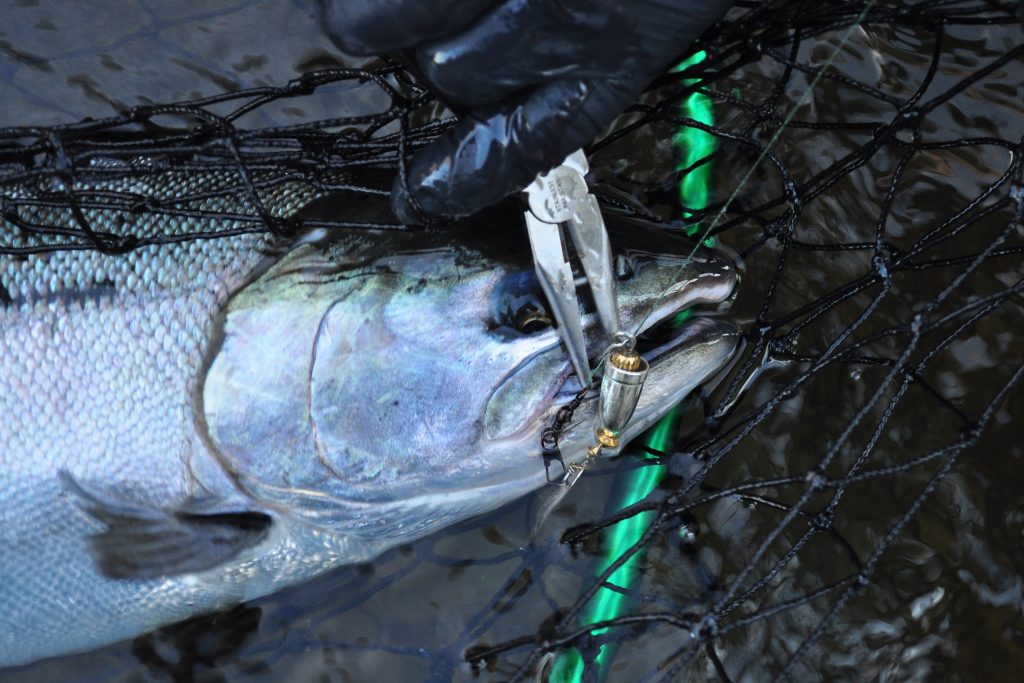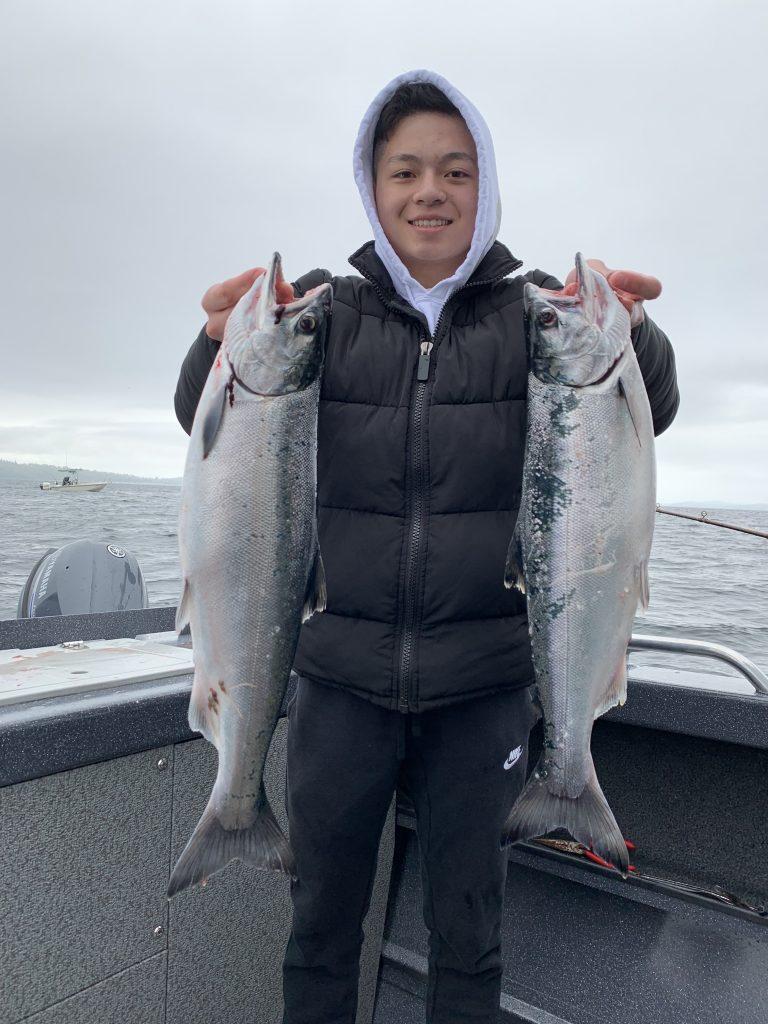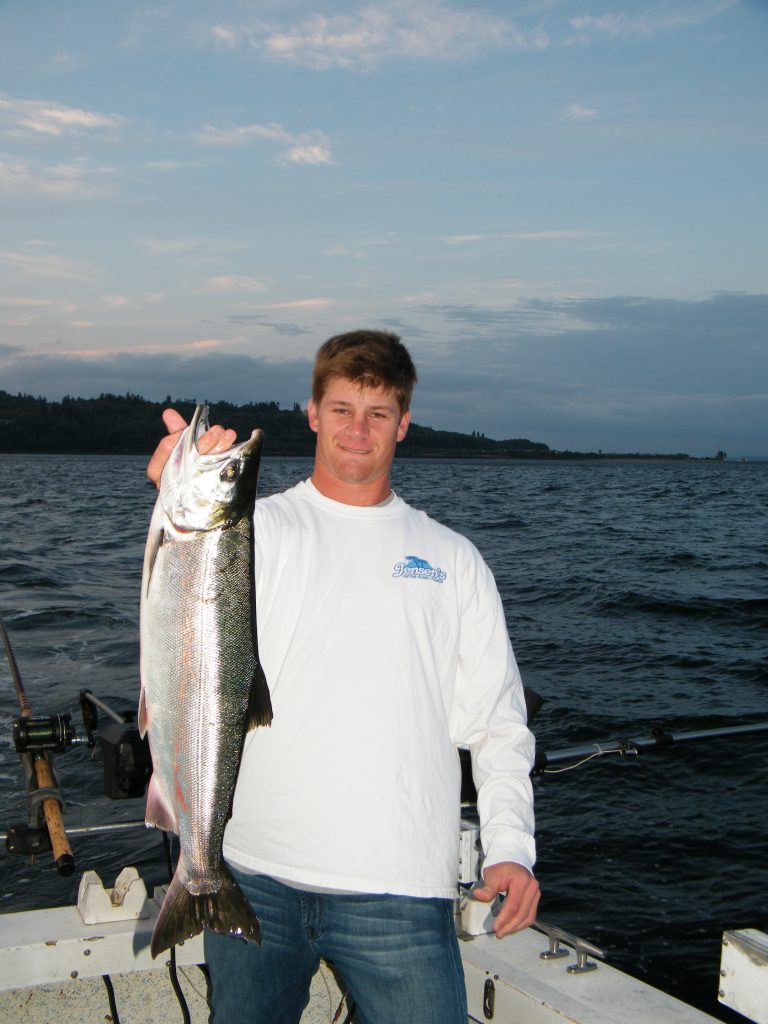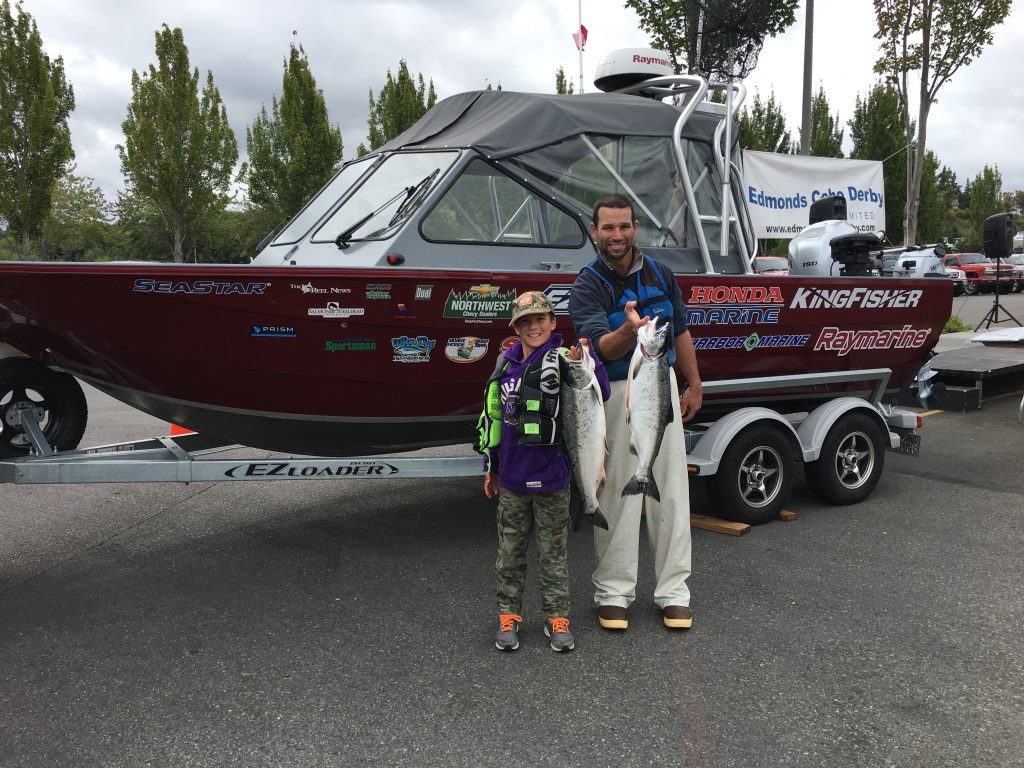Silver lining in salmon fisheries heading toward Puget Sound and look for good action heading into autumn 1

The front end of a long silvery coho salmon train – a fish better in the angler realm as “silvers” for their shiny chrome-bright bodies – has been steaming into the western Strait of Juan de Fuca off Sekiu in strong numbers for the past couple of weeks.
“Coho fishing at Sekiu really picked up and it did kind of drop off late this week, but the number of hatchery fish in the mix is making it a worthwhile trip,” said Larry Bennett, the head Washington Department of Fish and Wildlife (WDFW) sampler in Port Angeles. “Most of the coho are averaging 6 to 8 pounds. Port Angeles is still dead but hopefully that rain (on Thursday night) will push more coho our way.”
This is positive news for anglers and it’s only a matter of time before we see them build to a crescendo in Puget Sound and San Juan Island areas.
“I’m predicting a season like last year but with more opportunities in Puget Sound,” said Mark Baltzell, the WDFW Puget Sound salmon manager. “Once the coho get here there should be plenty of fish to catch especially since our hatchery return forecast will see a slight uptick.”
Optimism began to build a year ago when they surprised many with good fall fishing prospects. This came after a few previous years of dismal silver returns and anglers are now taking their hopes to the bank to cash in on a decent forecast of 670,159. That is up from 557,149 in 2018 and much higher than the dismal returns in 2017 and 2016.
Anglers started to see flashes of “silver madness” earlier this summer when their resident coho brothers and sisters appeared in strong numbers around central Puget Sound (Marine Catch Area 10).
Coho create plenty of excitement with boats lined up at boat ramps and hordes of anglers standing along shorelines and piers zinging gear at these fish that are known to leap out of the water and weave in all directions when hooked.
With the unexpected strong Puget Sound pink runs soon to be in the rearview mirror of the local saltwater fishing scene, anglers will now need to switch up their tactics to be successful.
For starters, coho prefer a faster presentation so pushing the throttle speed up to 2.8 to 3.5 mph is a key factor to scoring more hook ups.

Silvers tend to school and move around from place to place so keep a sharp eye on the fish-finder to see where the baitfish and fish are holding. Surface birds feeding on krill and baitfish schools is another way to know where the fish are lurking.
Boat anglers will mainly focus on the shipping lanes in rip tides and at the edge of a current where coho like to mingle.
Early morning hours and late evenings are usually when coho can be found within in the top 50 feet of the water column. Remember as the sun rises be sure to go deeper and drop your lines down 125 to 150 feet.
In the morning, set a couple rods at different depths from 25 to 45 feet and the others as deep as 50 to 80 feet below the surface. Once you hook a coho then immediately set the other rods to the same depth.
While I’m a devote mooching angler, I will switch to using downriggers as they enable an angler to keep their presentation at a specific depth while trolling.
On a downrigger tie the mainline to a barrel swivel. The leader to the lure or hooks should be about 6 to 8 feet of 25- to 30-pound monofilament tied to the flasher.
The bait of choice is either herring or artificial lures. Most will use flashers to create some motion to the lure or bait. Popular artificial lures are spoons like a Silver Horde Coho Killer or Kingfisher Lite or Luhr Jensen Coyote; plastic hoochies (2- to 4-inch squid imitations); and the Silver Horde Ace Hi Fly in a purple haze or green splatterback. Adding any artificial scent to your bait or lure will also help entice a bite.
A technique that became popular at Neah Bay was skipping a Bucktail fly across the surface when coho schools were abundant. Anglers place the flies behind the motor prop wash where bubbles and wake create a disturbance on the surface luring silvers to the surface. This is often referred to as an instinctive strike response.
Not having downriggers on the boat isn’t a hinderance and simply using a banana lead weight of 2- to 6-ounces will do the job, which is a technique often referred to as motor-mooching. Just be sure to kick the motor in and out of gear so the bait rises to the surface and drops back down to deeper depths.
You can also catch them drifting bait – mooching a cut-plug or whole herring – or vertical jigging with lead-style jigs.

The coast from Neah Bay south to Ilwaco (Marine Catch Areas 1 to 4) is open for hatchery coho through Sept. 30; Strait of Juan de Fuca from Sekiu to Port Angeles (5 and 6) is open for hatchery coho through Sept. 30; and San Juan Islands (7) is open for all coho through Sept. 30.
Locally, most will focus on northern Puget Sound (9) which is open for hatchery coho through Sept. 30; central Puget Sound (10) is open for all coho through Nov. 15; south central Puget Sound (11) is open for all coho through Sept. 30; and southern Puget Sound (13) is open year-round for hatchery coho.
Along the east side of Whidbey Island (8-2) the southern portion from the Mukilteo-Clinton line south and west towards the Area 9 boundary is open through Sept. 15 for hatchery coho and pinks only. This area was a hotbed for big coho in 2018 and anglers should see a similar scenario this season. Up north, Area 8-1 is open for all coho through Oct. 31.
Target coho in the shipping lanes from Sekiu to Port Angeles; Midchannel Bank off Port Townsend; west and east side of Whidbey Island; Point No Point; east side of Marrowstone Island; Possession Bar; Pilot Point; off Edmonds Marina south to Richmond Beach; Jefferson Head; Meadow Point near Shilshole Bay south to West Point; Shipwreck south of Mukilteo; Des Moines to Tacoma; and Browns Bay.
Shore-bound anglers can also catch their fair share of coho along the west side of Whidbey Island at Bush and Lagoon points, Fort Casey, Lincoln Park in West Seattle, Point No Point, Possession Point, Marrowstone Island, Point Wilson near Port Townsend, and various piers, docks and shorelines from Edmonds to Seattle and as far south as Tacoma.

Before hitting the water for coho be sure to check the WDFW pamphlet or website (https://wdfw.wa.gov/) for details and any emergency closures.
Derbies are a big draw during coho season, and the PSA Edmonds Coho Derby is Sept. 7 followed by the biggest derby on West Coast – the Everett Coho Derby on Sept. 21-22. Details: www.NorthwestSalmonDerbySeries.com.
The coho will begin their transition into local rivers and streams when the first big rains of autumn happen but even if it stays “rainless” in Seattle they’ll begin to show up from late September clear into November.
Once coho hit the rivers they become less focused on feeding and more on spawning, but there are ways to a finicky fish to bite or react aggressively to a lure or bait thrown in front of their face.
A Dick Nite Spoon with a dropper weight is the most popular river gear to use. Just make sure you bring a few different color choices like the 50/50 (nickle-brass), Frog UV, brass redhead, silver/chartreuse, chartreuse/pearl and silver/orange. Often a slight color or size change to your presentation can make or break going home fish-less or an ice chest full of silvers.
Another go-getter when casting from shore is a size 4 or 5 Blue Fox Vibrax Spinner. Once again different colors work on different days as related to water conditions and time of day. Chartreuse, flame orange, red/gold, green/silver or solid chrome are the top picks.
When fishing from a boat try a Yakima Bait Maglip 3.5, Brad’s Wiggler or a Wiggle Wart to cast or troll in slower sections of rivers. An old-school favorite is the Luhr Jensen Kwikfish Plug. The deep-diving smaller K11 to K13 works well in clearer water although the larger K14 or K15 with a sardine wrap is a more standard size. Color choices here are flame orange, cerise, purple, gold/orange and the fire tiger.
Another method is twitching jigs, which is casting a 3/8, 1/4 or 1/2-ounce hoochie or marabou jig in pink, blue, cerise, purple, red and orange. Cast jigs into slow moving water, let it sink and then slowly twitch the jig back to the boat or shore.
Other tried and true picks are Yakima Baits Lil’ Corky Drift Bobber; Beau Mac Tackle Cheater Drift Bobber with a piece of yarn or a cluster of salmon eggs; or a ball of cured salmon roe in a mesh netting.
Rivers fishing regulations can feel complicated at times so if you’re unsure, then check the WDFW pamphlet or website (https://wdfw.wa.gov/) on what you can or can’t keep, specific opening and closing dates and emergency closures.
The Stillaguamish is open Sept. 16-Nov. 15; Minter Creek opens Sept. 15-Dec. 31; Snohomish (pinks may be kept Sept. 1-3 only), Skykomish and Snoqualmie are open through Sept. 30; Cascade opens Sept. 16-Nov. 30; Lower Green below 212th Street Bridge is open through Dec. 31; Green from 212th Street Bridge to Highway 18 is open Sept. 16; Nisqually is open through Nov. 15 (closed on Sundays); Nooksack is open Oct. 1; Puyallup is open through Dec. 31; and Skagit is open through Dec. 31;
On the coast, try the Chehalis, Wynoochee, Clearwater, Satsop, Humptulips, Bogachiel, Calawah and Hoh.


Thanks for the article Mark. Do you have any additional tips for mooching or fishing with buzz bombs out on a boat in Area 10 or 9? About how long are the fish higher up in the water column during the mornings is it just for an hour or two after sunrise?